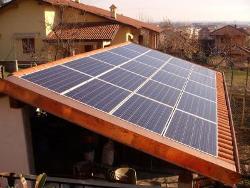Nov 5 2009
New scientific discoveries are moving society toward the era of "personalized solar energy," in which the focus of electricity production shifts from huge central generating stations to individuals in their own homes and communities.
That's the topic of a report by an international expert on solar energy scheduled for the November 2 issue of ACS' Inorganic Chemistry, a bi-weekly journal. It describes a long-awaited, inexpensive method for solar energy storage that could help power homes and plug-in cars in the future while helping keep the environment clean.
 A rooftop solar panel converts sunlight to electricity. In a new study, an expert describes progress toward an efficient and inexpensive method for storing and distributing solar energy in the home.
A rooftop solar panel converts sunlight to electricity. In a new study, an expert describes progress toward an efficient and inexpensive method for storing and distributing solar energy in the home.
Daniel Nocera explains that the global energy need will double by mid-century and triple by 2100 due to rising standards of living world population growth. Personalized solar energy - the capture and storage of solar energy at the individual or home level - could meet that demand in a sustainable way, especially in poorer areas of the world.
The report describes development of a practical, inexpensive storage system for achieving personalized solar energy. At its heart is an innovative catalyst that splits water molecules into oxygen and hydrogen that become fuel for producing electricity in a fuel cell. The new oxygen-evolving catalyst works like photosynthesis, the method plants use to make energy, producing clean energy from sunlight and water. "Because energy use scales with wealth, point-of-use solar energy will put individuals, in the smallest village in the nonlegacy world and in the largest city of the legacy world, on a more level playing field," the report states.